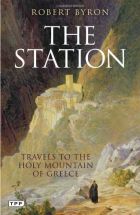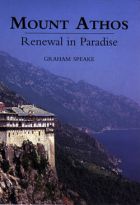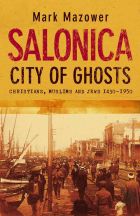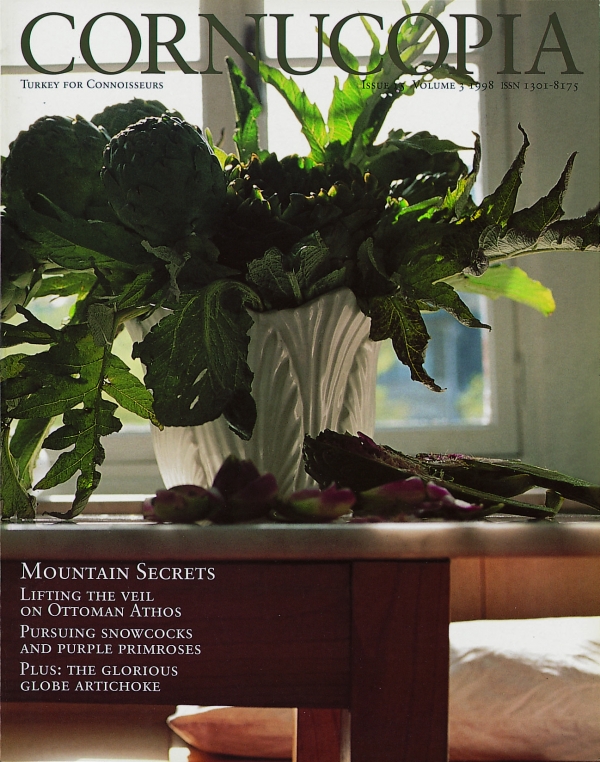Buy or gift a stand-alone digital subscription and get unlimited access to dozens of back issues for just £18.99 / $18.99 a year.
Please register at www.exacteditions.com/digital/cornucopia with your subscriber account number or contact subscriptions@cornucopia.net
Buy a digital subscription Go to the Digital EditionRobert Byron is a hard man to pin down. How to label him? Travel writer? Art historian? Bright Young Thing? A reissue of his 1927 travelogue The Station, with a new foreword by Christopher Sykes, his travel partner in Persia and Afghanistan, shows him to be all of the above and more. This account of his second visit to Mount Athos, the holiest site in Orthodoxy, combines political, religious and art history with a lively travelogue and cutting wit. Fortified by saddlebags laden with Fortnum & Mason chicken in aspic and tinned salmon, Byron and his companions for this particular journey, Mark Ogilvie-Grand and David Talbot Rice (whom he describes as a “cenotaph of competence, monolith of equanimity”), spent a summer exploring this “station of a faith where all the years have stopped”.
Inevitably, The Station will be compared to his acknowledged classic, The Road to Oxiana (1937), in which he seeks the Central Asian roots of Islamic architecture. In many ways The Station is a precursor to Oxiana, demonstrating that Byron had already developed a knack for the mixture of Waugh-esque snappiness and art-historical lyricism he would later develop to such fine effect. The Station is not, as Bruce Chatwin so forcefully described Oxiana, “a sacred text, beyond criticism”. However, it is essential reading for anyone interested in the development of Byron’s oeuvre, and given the influence which Byron had on those who followed in his footsteps, from Chatwin to William Dalrymple, The Station can be seen as a key text in the development of modern travel writing. The reader already acquainted with his later works might be left with a sense of déjà vu by certain passages, such as the dialogue with a Turkish customs officer which occurs early on in the narrative.
The book has flaws, not the least of which is the author’s subjecting the reader to an endless flow of frankly superfluous information on the ins and outs of the last thousand years of Athonite history. Obviously a degree of background knowledge is essential, but this occasionally reads more like notes for an undergraduate lecture than a travelogue – although perhaps we should not be surprised by this, given that Byron had only recently graduated from Oxford. He himself recognised this problem and writes in his own defence that “if patches are purpled with the past… let the reader recall his own schoolroom and discover the excuse”.
As with all of Byron’s works, the reader is regularly subjected to the violence of both his passions and his prejudices: Sykes notes in his new introduction that Byron’s “pugnacity and his unreflecting optimism destroy so much of the value of the criticism”. At times his obsessions are taken too far: his claims to detect an affinity between the Potala in Lhasa, Simopetra in Athos and the modernist architecture of the 1920s, for instance, leave much to be desired in their logic. On the other hand, he occasionally produces prose of such wonderful clarity that it can be placed alongside the great art-historical works of the 20th century. His description of the frescoes in the chapel of St George is at least the equal of his famed description of the Gunbad-i Qabus in Oxiana, and are worth the price of the book alone: “Let him who still conceives of Byzantine painting as a hieratic degradation, imagine a Giotto unsweetened, as Giotto already was, by Italianate naturalism, painting in the luminous colours of El Greco – those cold blues and clarets, olive-shadowed yellows, and pure, clear greens of under the sea; lit with angry brilliance; geometric in form; yet in austerity sympathetic, in power gentle.”
In The Station Byron comes across as an altogether more pleasant individual than in Oxiana. At no point does he resort to physical violence – perhaps because here he is in the holiest place, the only living remnant of his beloved Byzantium, rather than from any lingering youthful kindness. On this occasion it is Talbot Rice, the great Byzantinist, who ruffles feathers, nonchalantly smashing the locks on a chapel door when denied access.
As with his other travel books, current events cannot help but enter into his discussion of vanished empires and exquisite art. First Russia, Then Tibet (1933) criticised Stalinism at a time when its horrors were less apparent, while Oxiana dealt, albeit obliquely, with the shifting power politics of the Middle East and Central Asia. Behind the architectural marvels and picturesque monks of The Station is a portrait of a world in flux, left reeling from the awful aftershocks of nationalism, revolution and the collapse of empire. The apparently impregnable and unchanging mountain is shown as suffering from the Balkan Wars, the First World War, the Russian Revolution and the disastrous Greek campaign in Anatolia. The sheer amount of outside interference in this holy place is breathtaking, and largely unknown outside academic circles. How astonishing it is to learn that in 1913 the preaching of a mystically minded monk led to the landing of Russian troops there, or that the Greek dictator Pangalos considered turning the mountain into, of all things, a casino.
Byron is gratifyingly even-handed when it comes to the people involved in these periodical upheavals, and he is fully aware that the Ottomans, far from oppressing this stronghold of Eastern Christianity, did a far better job of maintaining it than the modern Greeks. In a section on the capture of the mountain in 1912, he allows the Turkish kaymakam to present the Ottoman case eloquently: “Always the West is talking of Turkish fanaticism. But what race, I ask you, what conqueror could have treated these people with greater humanity, greater moderation, greater religious tolerance? …They will regret us, monsieur.”
As a dip into a closed world; as an enjoyable diatribe against moribund good taste and received wisdom; as exquisite vignettes of a golden summer with friends, The Station, imperfect as it is, fulfils all of these descriptions. To paraphrase John Updike on Nabokov, Byron wrote about travel the only way it should be written – ecstatically.
The İzbeli family have owned a country konak south of Kastamonu since the 17th century. Today the house, with its magnificent barns, is one of the best-preserved Ottoman country houses in Turkey
The jewel in Kastamonu’s crown is a mosque in Kasaba, a tiny village with a flock or two of sheep, guarded by shepherdesses, in a sea of wheat fields. Built in 1366, the Mosque of Mahmut Bey is a brilliant relic of the golden age of the Anatolian beyliks, the warring principalities that flourished when the great Byzantine and Seljuk empires were in decline
At London’s inaugural Wines of Turkey jamboree, Kevin Gould hears how the country’s winemakers are cultivating a taste for their distinctive products
Strawberries growing in the wild are gems of mouth-watering delight that bear little relation to the showy, insipid-tasting fruit on supermarket shelves. But there are still good garden strawberries to be found. Berrin Torolsan encourages us to seek out locally grown, seasonal fruit bursting with fragrance. Her simple recipes celebrate the best of berries
John Frederick Lewis (1804–76), was the supreme orientalist, fêted for his sumptuous Ottoman scenes. The secret of his success, says Briony Llewellyn, lies in the vivid sketches he made during his time in the East
Intrigued by the fate of the glorious houses built by Azerbaijan’s first oil barons at the turn of the 20th century, Brigid Keenan and photographer Tim Beddow track down all that remains of those glory days






Cornucopia works in partnership with the digital publishing platform Exact Editions to offer individual and institutional subscribers unlimited access to a searchable archive of fascinating back issues and every newly published issue. The digital edition of Cornucopia is available cross-platform on web, iOS and Android and offers a comprehensive search function, allowing the title’s cultural content to be delved into at the touch of a button.
Digital Subscription: £18.99 / $18.99 (1 year)
Subscribe now